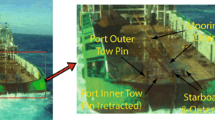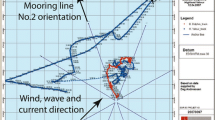Abstract
To ensure safety in anchor handling operations, maintaining anchor handling vessel stability is recognized as a critical and complex task. The vessel’s stability depends primarily on the vessel’s design and operational parameters, which are expressed by the vessel’s dynamic rolling angle, static heeling angle, and capsizing angle. The vessel’s stability during anchor handling operations (AHOs) is possible to attain by means of maintaining the vessel’s heading in line with the mooring line direction. However, lessons learned from past accidents show that normal and abnormal events and gross errors can lead to capsizing. The occurrence of a large deviation between the vessel heading and the mooring line direction due to abnormal events is considered to be an accidental limiting condition. In this study, two stability criteria are established: (1) the critical static heeling angle criterion and (2) the critical rolling angle criterion. The first criterion is useful in the design phase for assessing the vessel’s allowable static heeling angle for a well-defined operational sea state. The second criterion is useful for assessing the vessel’s stability in the analysis and planning phase of the operation. A case study is conducted on the Bourbon Dolphin (BD) accident for assessing the stability in a capsizing scenario. The predicted results show that the BD can maintain stability under normal conditions but not under an accidental condition during anchor deployment. While assessing a vessel’s intact stability, it is essential to account for the effect of normal uncertainty and variability on the operational parameters; this aspect is investigated in this paper through a sensitivity study.
















Similar content being viewed by others
References
Lyng I, Andreassen D, Fiksdal GAH (2008) Official Norwegian Reports: the loss of the “Bourbon Dolphin” on 12 April 2007. Technical Report NOU 2008: 8, Submitted to the Royal Norwegian Ministry of Justice and the Police on 28 March 2008. Oslo, Norway
IMO SDC 3/WP.5. (2016) Finalization of Second Generation Intact Stability Criteria, Amendments to Part B of the 2008 IS Code on Towing, Lifting and Anchor Handling Operations. London, UK
Vryhof Anchors (1999) Anchor manual 2000. Krimpen ad Yssel, The Netherlands
Gibson V (1999) Supply ship operations. Oilfield Publications Limited, Ledbury
Hancox M (1994) Anchor handling. Oilfield Publications Limited, Ledbury
Maudsley PR (1995) Operation of offshore supply and anchor handling vessels, 1st edn. The Nautical Institute, London
Ritchie G (2007) Practical introduction to anchor handling and supply vessel operations, 2nd edn. Clarkson Researches Services Limited, London
Gunnu GRS, Moan T, Chen H (2010) Risk influencing factors related to capsizing of anchor handling Vessels in view of the bourbon dolphin accident. In: The international conference on systems engineering in ship and offshore design. Royal Institution of Naval Architects, Bath, UK
Wu X, Gunnu GRS, Moan T (2015) Positioning capability of anchor handling vessels in deep water during anchor deployment. J Mar Sci Technol 20:487–504
Gunnu GRS, Wu X, Moan T (2012) Anchor handling vessel behavior in horizontal plane in a uniform current field during operation. In: Choo YS, Edelson DN, Mills T (eds) The 2nd marine operations specialty symposium (MOSS 2008). Research Publishing Services, Singapore, pp 307–324
Gunnu GRS, Moan T (2012) Stability assessment of anchor handling vessel during operation considering wind loads and wave induced roll motions. In: The 22nd international offshore and polar engineering conference. ISOPE, Rhodes
Moan T (2009) Development of accidental collapse limit state criteria for offshore structures. Struct Saf 31(2):124–135
Kletz TA (2001) An engineer’s view of human error, 3rd edn. IChemE, Rugby
Reason J (1990) Human error. Cambridge University Press, New York
Senders JW, Moray NP (1991) Human error: cause, prediction, and reduction. Lawrence Erlbaum Associates, Hillsdale
Hollnagel E (1998) Cognitive reliability and error analysis method (CREAM). Elsevier, Amsterdam
Wickens CD, Hollands JG, Banbury S, Parasuraman R (2013) Engineering psychology and human performance, 4th edn. Pearson Education Inc, Upper Saddle River
Nielsen LG (2004) Stevns Power capsizing and foundering during anchor handling operation on 19 October 2003. Tech. Rep. 199940518, Division for investigation of maritime accidents, Danish Maritime Authority, Copenhagen, Denmark, p 59
Belenky VL, Sevastianov NB (2007) Stability and safety of ships: risk of capsizing, 2nd ed. The Society of Naval Architects and Marine Engineers (SNAME), Jersey City
Francescutto A (2002) Sea waves and ship safety-state of art in current regulations. Proceedings of the 12th International Offshore and Polar Engineering Conference. International Society of Offshore and Polar Engineers (ISOPE), Kitakyushu, pp 150–155
Francescutto A (2004) Intact ship stability: the way ahead. Mar Technol 41(1):31–37
Kobylinski LK, Kastner S (2003) Stability and safety of ships. Volume I: regulation and operation, 1st ed. Elsevier Ocean Engineering Book Series, Elsevier, Amsterdam
Neves MAS, Belenky VL, de Kat JO et al (2011) contemporary ideas on ship stability and capsizing in waves. Springer, Dordrecht
Vasconcellos JM, Oliveira NG (2011) Risk in stability evaluation for floating offshore units. Ocean Eng 38(8):967–975
ABS (1990) Guide for application of dynamic response based intact stability criteria for column-stabilized mobile offshore drilling units, 1990. American Bureau of Shipping, New York
ABS (1997) Rules for building and classing offshore mobile drilling units, part 3; Hull Construction and Equipment. American Bureau of Shipping, New York
DNV (1998) Rules for Classification of Mobile Offshore Units, Part 3, Chapter 2, Special Designs, Equipment and Stability. Det Norske Veritas, Oslo
IMO (1992) Code for the Construction and Equipment of Mobile Offshore Drilling Units (MODU Code), 1991 Amendments to the 1979 and 1989 Codes. International Maritime Organization, London
IMO (2009) International Code on Intact stability, 2008–2009 Edition. International Maritime Organization, London
LRS (1996) Rules and regulations for the classification of mobile offshore units. Lloyd’s Register of Shipping, London
NMD (1992) Rules for mobile offshore units. Norwegian Maritime Directorate, Oslo
Martinovich WM, Praught MW (1986) Stability requirements for semisubmersibles: a designers view point. Stationing and Stability of Semi-submersibles: Proceedings of an International Conference. Society of Underwater Technology, University of Strathclyde, UK, pp 3–40
Mills PJ, Stoneman GS, Wilson TB (1991) Stability of Ships and Mobile Offshore Units. Recent Developments in Legislation. Lloyd’s Register Technical Association, paper no. 7, session 1990–91, London, UK
IMO (2007) Guidelines for the design and construction of offshore supply vessels 2006. International Maritime Organization, London
De Jong G (2014) New regulations for towing and anchor handling vessels: the future is now. 23rd International Tug, Salvage & OSV Convention and Exhibition, CCH Congress Centrum, Hamburg, Germany
De Jong G (2010) The class answer to the rapidly developing tug industry. 21st International Tug & Salvage Convention & Exhibition, Vancouver: ABR Company Ltd, Canada
Mantari JL, Ribeiro e Silva S, Guedes Soares C (2009) Variations on transverse stability of fishing vessels due to fishing gear pull and waves. Proceedings of the XXI Pan American Congress of Naval Engineering (COPINAVAL´09), Montevideo, Uruguay
Barltrop NDP (1998) Floating Structures: a guide for design and analysis. Oilfield Puclications Limited, Herefordshire
IMO (1985) Resolution A.562 Recommendations on a Severe Wind and Rolling Criterion for the Intact Stability of Passenger and Cargo Ships of 24 meters in Length and over. International Maritime Organization, London, UK
Sarchin TH, Goldberg LL (1962) Stability and Buoyancy Criteria for US Naval Surface Ships. Trans Soc Nav Archit Mar Eng 70:418–458
IMO (1982) Weather Criteria, Results on Japanese Ships, Submitted by Japan, Doc. SLF/7. International Maritime Organization, London, UK
IMO (2006) Revised Intact Stability Code Prepared by the Inter sessional Correspondence Group (Part of the Correspondence Group’s report): Submitted by Germany, Doc. SLF 49/5. International Maritime Organization, London, UK
Japan (1979) Intact Stability, Stability of Ships in Ballast Condition, Weather Criteria. IMCO - Sub-Committee on Subdivision, Stability and Load Lines - 24th session, STAB XXIV/4
Japan (1981) Intact Stability, Results of Calculation for the Sample Ship. IMCO - Sub-Committee on Subdivision, Stability and Load Lines, STAB/95
Watanabe Y, Kato H, Inoue S, et al (1956) A Proposed Standard of Stability for Passenger Ships: Part III: Ocean-going and Coasting Ships. J Soc Nav Archit Jpn(99) 29–46
USSR (1961) Standards of Stability of Sea-Going Vessels and Coasters. Register of Shipping of the USSR, Morskoi Transport, Moscow
Deybach F (1997) Intact stability criteria for naval ships. M.Sc. Thesis, Department of Ocean Engineering, Massachusetts Institute of Technology
DNVGL Sesam HydroD (2015) Sesam HydroD v4. 6-03. Det Norske Veritas Software, Høvik, Oslo, Norway
Nilsson M (2009) Stability aspects during anchor handling operations. M.Sc. Thesis in Naval Architecture, Department of Aeronautical and Vehicle Engineering, KTH, Royal Institute of Technology
Fathi D, Hoff JR (2004) ShipX Vessel Responses (VERES). MARINTEK AS, Trondheim
Acknowledgments
The authors would like to acknowledge financial support from the Research Council of Norway through SINTEF Fisheries and Aquaculture, and CeSOS and would especially like to thank Vegar Johansen for his support.
Author information
Authors and Affiliations
Corresponding author
About this article
Cite this article
Gunnu, G.R., Moan, T. Stability assessment of anchor handling vessels during operations. J Mar Sci Technol 23, 201–227 (2018). https://doi.org/10.1007/s00773-017-0465-7
Received:
Accepted:
Published:
Issue Date:
DOI: https://doi.org/10.1007/s00773-017-0465-7




